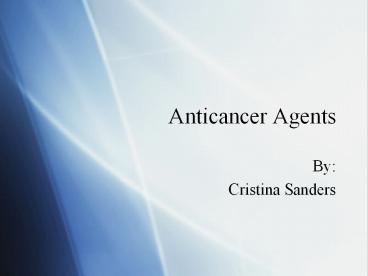Anticancer Agents - PowerPoint PPT Presentation
Title:
Anticancer Agents
Description:
Anticancer Agents By: Cristina Sanders * * * * * * * * * * * * * * * * * * * * What is cancer? Cancer is a group of diseases that are characterized by the loss of ... – PowerPoint PPT presentation
Number of Views:929
Avg rating:3.0/5.0
Title: Anticancer Agents
1
Anticancer Agents
- By
- Cristina Sanders
2
What is cancer?
- Cancer is a group of diseases that are
characterized by the loss of control of the
growth, division, and spread of a group of cells
leading to a primary tumor that invades and
destroys adjacent tissues - Become rogue cells and
frequently lose their
differentiation - Two types benign and malignant
- Spread through metastasis
3
How cancer develops
- Can be inherited or develop by being exposed to
certain environmental factors (cigarette smoke,
alcohol, certain diets) - Tumorigenesis - accumulation of mutations in
oncogenes that deregulates the cell cycle - Cancer Link
4
Cell cycle
5
History of Cancer Treatment
- Long history of treating cancer, but did not
successfully begin until the invention of the
microscope - Early 20th - surgery and radiation
- World Wars began chemical warfare, and thus began
chemotherapy - nitrogen mustards - Currently, targeted cancer therapy
6
Common Treatments
- Surgery
- Direct removal of tumor
- Radiotherapy
- Using ionizing radiation to control malignant
cells - Chemotherapy
- Using chemicals to kill actively dividing cells
7
Chemotherapy
- Injection - Intrathecal, Intramuscular,
Intravenous, Intra-arterial - Orally
- Topically
8
Drug targets
- Enzymes - Antimetabolites
- Hormones - Androgens, Oestrogens, Progestins,
LHRH agonists, Antioestrogens, Antiandrogens - Nucleic Acids - Intercalating agents, alkylating
agents, chain cutters - Structural proteins
- Signaling pathways
9
Intercalating Agents
- The reversible inclusion of a molecule between
two other groups, most commonly seen in DNA - Inhibits DNA replication in rapidly growing cells
10
Anthracyclines
- First anthracycline antibiotics were isolated
from Streptomyces peucetius in 1958 - Interact with DNA by intercalcation and inhibit
topsoimerase - Some of the most effective cancer drugs available
- Very wide spectrum
11
Common Anthracyclines
- Daunorubicin (Cerubidine)
- Doxorubicin (Adriamycin, Rubex)
- Epirubicin (Ellence, Pharmorubicin)
- Idarubicin (Idamycin)
12
Anthracycline structures
http//images.google.com/imgres?imgurlhttp//www.
ncbi.nlm.nih.gov/bookshelf/picrender.fcgi3Fbook3
Dcmed26part3DA1164426blobname3Dch49f5.jpgimgr
efurlhttp//www.ncbi.nlm.nih.gov/bookshelf/br.fcg
i3Fbook3Dcmed26part3DA11644usg__1ixIg12np9lq
0vQwN14mBnjs5oUh744w412sz53hlenstart2u
m1itbs1tbnidTYigCqbnaRkjfMtbnh141tbnw78
prev/images3Fq3Dcommon2Banthracyclines26um3D
126hl3Den26sa3DN26rlz3D1G1GGLQ_ENUS25126tbs
3Disch1
13
DOX vs. DNR
- Daunomycin (DNR) for acute lymphocytic and
myeloid leukenmia - Doxorubicin (DOX) for chemotherapy for solid
tumors including breast cancer, soft tissue
sarcomes, and aggressive lymphomas
14
Mechanisms of action
- Disrupt DNA
- Intercalate into the base pairs in DNA minor
grooves - Inhibits topoiosomerase II enzyme, preventing the
relaxing of supercoiled DNA, thus blocking DNA
transcription and replication - Cause free radical damage of ribose in the DNA
15
Intercalating Mechanism
- The planar aromatic chromophore portion of the
molecule intercalates between two base pairs of
the DNA, while the six-membered daunosamine sugar
sits in the minor groove and interacts with
flanking base pairs immediately adjacent to the
intercalation site - Prevents Topoisomerase II and stabilizes the
complex, preventing the DNA helix from resealing
16
Free Radical Formation
- Adds to the cardiotoxicity of anthracyclines
17
Negative Effects
- Causes cardiotoxicity
- Interference with ryanodine receptors of the
sarcoplasmic reticulum in the heart muscle cells - Free-radical formation in the heart
- Leads to forms of congestive heart failure, often
years after treatment - Counteract with dexrazoxane
18
Bleomycins (BLM)
- Natural glycopeptidic antibiotics produced by
Streptomyces verticillus - Efficacy against tumors
- Mainly used in therapy in a combination with
radiotherapy or chemotherapy - Commonly administered as Blenoxane, a drug that
includes both bleomycin A2 and B2.
19
History of Bleomycins
- First discovered in 1966 by Hamao Umerzawa from
Japan when screening cultures of S. verticullus - Launched in Japan by Nippon kayaku in
1969 - Initially marketed by Bristol-Myers Squibb
under brand name Blenoxance
20
Structure
21
Mechanism
- Induction of DNA strand breaks
- Medicate DNA strand scission of single and double
strand breaks dependent on metal ions and oxygen - Bleomycin Action 210, 313
22
Side effects
- Pulmonary fibrosis and impaired lung function
- Age and dose related
- Capillary changes, atypical epithelial cells
23
Resistance to Anticancer Agents
- Resistance mechanisms can operate to
- Prevent agents from entering cells, as in loss of
plasma membrane carriers for nucleoside analogs - Enhance their extrusion, as exemplified by
energy-dependent pumps such as ABC transporters
24
Reading Assignment
- Patrick, Graham L. An Introduction to Medicinal
Chemistry. 3rd ed. Oxford Oxford University
Print, 2005. p.489-504 - Hurley, Laurence H. DNA and its associated
processes as targets for cancer therapy.
Nature Reviews Cancer (2002), 2(3), 188-200.
25
Homework Questions
- What are some cellular defects that are
associated with cancer? - Describe the mechanism of DNA intercalation and
how it is used to treat cancer. - Draw the two main structures of Anthracyclines
and label the areas involved in the mechanism of
action. - How does doxorubicin interfere with topoisomerase
II?
26
References
- Avenda, Carmen, and J. Carlos Menedez. Medicinal
Chemistry of Anticancer Drugs. Amsterdam
Elsevier, 2008 http//www.scribd.com/doc/11639473/
Medicinal-Chemistry-of-Anticancer-Drugs - Chang, Jingyang, and JoAnne Stubbe. "Bleomycins
New Methods Will Allow Reinvestigation of Old
Issues." Current Opinion in Chemical Biology 8.2
(2004) 175-81. - Claussen, Craig A., and Eric C. Long "Nucleic
Acid Recognition by Metal Complexes of
Bleomycin." Chemical Reviews 99 (1999) 2797-816. - Hortobyi, G. N. "Anthracyclines in the Treatment
of Cancer An Overview." Drugs 54 (1997) 1-7. - Hurley, Laurence H. "DNA And Its Associated
Processes as Targets For Cancer Therapy." Nature
2 (2002) 188-200. EBSCOhost. Web. 28 Mar. 2010.
lthttp//web.ebscohost.com/ehost/pdf?vid2hid107
sidc129efcf-31ba-47d2-960d-dfb68ea0e0bd40session
mgr104gt. - Papac, Rose J. "Origins of Cancer Therapy." Yale
Journal of Biology and Medicine 74 (2002)
391-98. http//www.ncbi.nlm.nih.gov/pmc/articles/P
MC2588755/?page1 - Patrick, Graham L. An Introduction to Medicinal
Chemistry. 3rd ed. Oxford Oxford University
Print, 2005. - Pratt, William B. The Anticancer Drugs. New York
Oxford UP, 1994. - http//www.cancerquest.org/index.cfm?page2225
- http//knol.google.com/k/history-of-cancer-treatme
ntHistory_of_Cancer_Treatmenthttp//www.drugs.com
/sfx/bleomycin-side-effects.html































